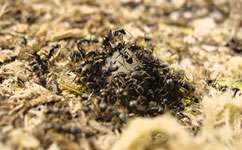Nature and nurture help ant societies run smoothly

Picture an ant colony: up to a million ants, all looking identical, harmoniously going about their busy ant lives. But with so many ants around, how on Earth do they know who's friend and who's foe?
Well, it all depends on the chemicals on their bodies, which until now scientists thought were determined solely by the ants' genes. Now, the latest research suggests the situation might be just a little more complex.
Scientists have found that in colonies with lots of queens – and so lots of genetic diversity or mixing of genes – the chemicals the ants use to identify each other are no more varied than in colonies with less gene mixing.
In other words, even though ants in colonies ruled by many queens are genetically varied, the chemicals they use to communicate are no more diverse than in colonies with one queen.
Chemical world
Being able to recognise who's who in an ant colony is crucial for it to run smoothly. Ants need to be able to get rid of intruders quickly, whether they're parasites, or ants from another colony stealing their food or brood. And while we rely on sight, ants live in an almost exclusively chemical world.
'We're an incredibly visual species compared with ants,' explains Dr Stephen Martin from the University of Sheffield, a member of the team behind the study. 'Ants and other insects use vision and sound, but the vast majority of their communication is chemical.'
Scientists know that once born into a colony, ants get a multi-layered smell profile, which their nest mates use to recognise them.
But as genetic diversity in a colony increases – as a result of having lots of queens – it's logical to expect an increase in chemical diversity. So does this mean that ants aren't as good at recognising each other in multi-queen colonies, or do they have a wider 'recognition window'?
To find out, Martin and colleagues from the universities of Helsinki, Sheffield and Keele compared genetic diversity, chemical diversity and recognition behaviour in the common black ant Formica fusca.
'These ants lives in both multi-queen and single queen societies, so they're a perfect species to study,' says Martin.
Despite more genetic diversity in colonies which can be ruled by up to 20 queens, the researchers found no difference in the diversity of chemical recognition cues in these ants.
'Ant colonies with multiple queens have a lot of genetic diversity, which you might expect would mean increased chemical diversity, and therefore less nest mate recognition,' Martin says. 'But we didn't find that at all.'
Using aggression bioassays the researchers also found no difference in how ants in each colony responded to each other, even though ants in the colonies with lots of queens are less closely related.
One possible explanation is that ants from the same colony transfer odours to each other as they exchange food, because they have glands connected to the ant's throat, which are full of chemicals used in recognition. This would mix chemicals up, resulting in colony-specific chemicals, which ants might use to identify each other with.
Whatever the truth is, the findings suggest that genes alone aren't what dictate which chemicals ants host on their bodies. These chemicals may instead be determined by a complex mix of both genes and the environment.
'Understanding how ants recognise each other will teach us how societies have evolved,' says Martin. 'Ants have been on this planet for more than 80 million years, which means that they have had a long time to evolve a very complex, but fully-functioning recognition system that will rival our own visual recognition system.'
The research is published in Behavioral Ecology.
This story is republished courtesy of Planet Earth online, a free, companion website to the award-winning magazine Planet Earth published and funded by the Natural Environment Research Council (NERC).
More information: Heikki Helanteräa, Yasmin R. Leeb, Falko P. Drijfhoutc and Stephen J. Martin, Genetic diversity, colony chemical phenotype, and nest mate recognition in the ant Formica fusca, Behavioral Ecology, First published online: April 6, 2011, doi: 10.1093/beheco/arr037
Source: PlanetEarth Online


















